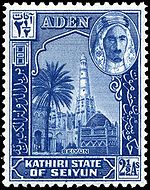Kathiri
| Kathiri State of Seiyun ٱلدَّوْلَة ٱلْكَثِيْرِيَّة ٱلْحَضْرَمِيَّة فِي سَيْؤُوْن ٱلْكَثِيْرِي al-Kathīrī | |||||||
|---|---|---|---|---|---|---|---|
| State of the Aden Protectorate and the Protectorate of South Arabia | |||||||
| 1395–1967 | |||||||
 Flag | |||||||
 Map of the Protectorate of South Arabia 1965 | |||||||
| Capital | Say'un | ||||||
| Area | |||||||
| • Coordinates | Coordinates: 17°10′N 50°15′E / 17.167°N 50.250°E | ||||||
| • Type | Sultanate | ||||||
| Historical era | 20th century | ||||||
• Established | 1395 | ||||||
• Disestablished | 30 November 1967 | ||||||
| |||||||
| Today part of | Yemen Saudi Arabia Oman | ||||||
| EB | |||||||
Kathiri (Arabic: ٱلْكَثِيْرِي, romanized: al-Kathīrī), officially the Kathiri State of Seiyun (Arabic: ٱلسَّلْطَنَة ٱلْكَثِيْرِيَّة - سَيْؤُوْن, romanized: al-Salṭanah al-Kathīrīyah - Sayʾūn) was a sultanate in the Hadhramaut region of the southern Arabian Peninsula, in what is now part of Yemen and the Dhofari region of Oman.
History[]
The Kathiri State was established in 1395 by Badr as-Sahab ibn al-Habrali Bu Tuwairik, who ruled until c. 1430.[1] The Kathiri conquered Ash-Shihr in the 1460s.[2]

The country inhabited by this tribe was formerly extensive, reaching from the Aulaqi districts on the west to the Maliri tribe on the east, and including the seaports of Mukalla and Shihr. Civil wars led to the interference of the Yafai, and much of the Kathiri territory came under the sway of the Kasadi and Qaiti.[3] The Kathiris were eventually restricted to a small inland portion of Hadhramaut with their capital at Seiyun (Say'un).[4]
At the end of 1883 Sultan Abdulla bin Salih, one of the Kathiri Shaikhs visited the Resident at Aden. His principal object was to ascertain what attitude the British Government would maintain in the event of the Kathiri attacking the Qaiti with a view to repossessing themselves of the ports of Shihr and Mukalla. Abdulla bin Salih also visited Zanzibar with intent to intrigue with the ex-Naqib of Mukalla, from whom however, he failed to obtain any material assistance.[3]
The Government of India in March 1884 directed that the Kathiri be warned that an attack upon Shihr and Mukalla would he viewed with grave displeasure, and that, if necessary, a gun-boat would he sent to support the Quaiti ruler. The Jamadar of Shihr and Mukalla was subsequently assured in the most public manner that Government would support him in the event of any attack on his ports.[3]
In 1895 the Kathiri captured the port at Dhufar driving out the Governor, who retired to Mirbat. In 1897 the port was recaptured.[3] Removed In 1918 a 'long standing Qaiti-Kathiri quarrel was settled, with the assistance of the Aden Residency, by the conclusion of an Agreement between the parties, by which the Kathiri agreed to accept as binding upon them the treaty of 1888 between the Qaiti and the British Government and also accepted the arbitration of the British Government in the settlement of future disputes.[3]
Sultan Mansur bin Ghalib died at Mecca in May 1929 and was succeeded by his son Ali bin Mansur.[3]
The Kathiri State declined to join the Federation of South Arabia, but remained under British protection as part of the Protectorate of South Arabia. Al-Husayn ibn Ali, Kathiri sultan since 1949, was overthrown in October 1967, and the following month the former sultanate became part of newly independent South Yemen.[5]
South Yemen united with North Yemen in 1990 to become the Republic of Yemen, but local sheikhs in Yemen are reported to still wield large de facto authority.[citation needed]
The first Prime Minister in the history of East Timor, Mar'ī al-Kathīrī, is a third generation descendant of immigrants from Kathiri, part of a significant migration of Hadhramis to Southeast Asia in the 19th and 20th centuries. This is reflected in his name 'Alkatiri'. The Indonesian human rights activist Munir Said Thalib is also a descendant of immigrants from the Kathiris.[citation needed]
See also[]
References[]
- ^ Gordon, Bruce. "Regnal Chronologies - Arabia". Archived from the original on 24 July 2020.
- ^ Gavin, R. J. (1975). Aden Under British Rule, 1839-1967. Hurst. p. 13. ISBN 978-0-903983-14-3.
- ^ Jump up to: a b c d e f Aitchison, G (1931). A Collection Of Treaties, Engagements And Sanads Relating To India And Neighbouring Countries. xi. Government of India. pp. 30–31.
 This article incorporates text from this source, which is in the public domain.
This article incorporates text from this source, which is in the public domain.
- ^ Stark, Freya. The Southern Gates of Arabia: A Journey in the Hadhramaut.
- ^ Oron, Yitzhak, ed. (1960), Middle East Record, 1
External links[]
| Wikimedia Commons has media related to Kathiri State of Seiyun. |
- Flag of Kathiri State
- Ba Wazir of the Hadhramaut - Lines in the sand – epilogue
- States of the Yemen Protectorate
- Royal Forums
- Hubert Herald - Yemen
- States and territories established in 1395
- States and territories disestablished in 1967
- Sultanates
- States in the Aden Protectorate
- Protectorate of South Arabia
- Arab dynasties
- Former polities of the Cold War
- Former countries
